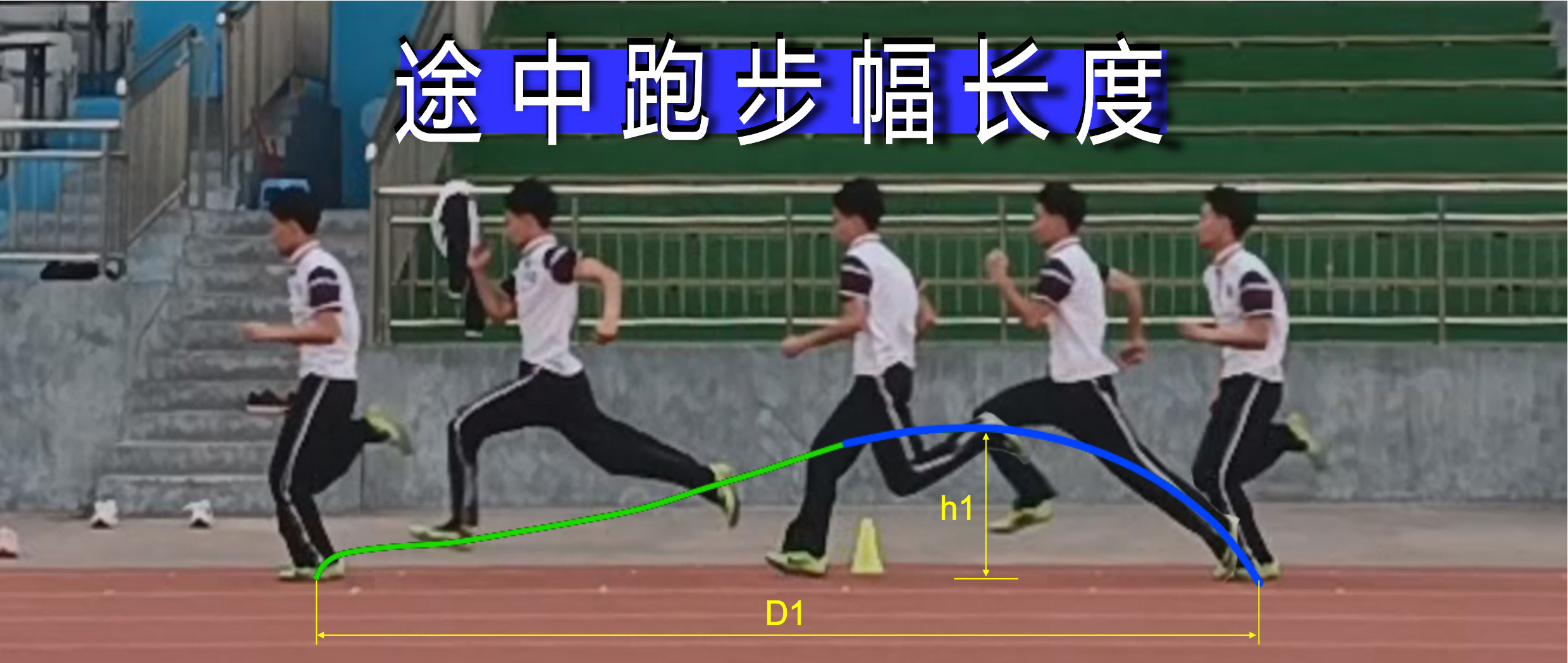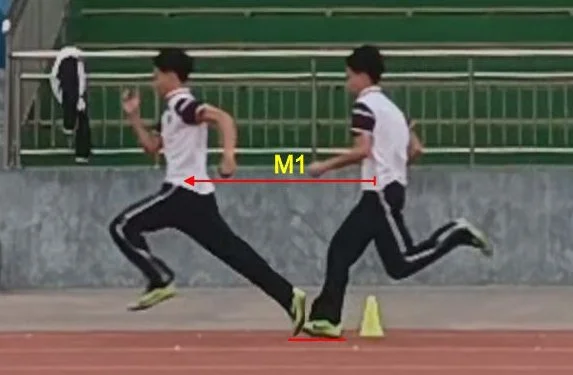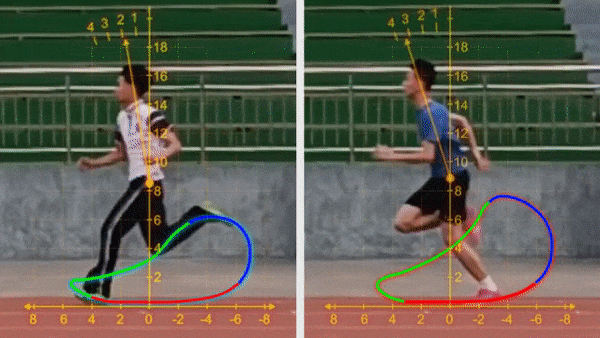UNDERSTANDING STRIDE LENGTH IN RUNNING
Introduction
Stride length is a dynamic result of biomechanics, technique, and the way the body moves through each stride. Understanding this not only helps runners improve performance but also challenges common assumptions about what makes a “long stride.”
In this article, we will explore the difference between foot strike distance and stride length, examine the foot’s trajectory during running, and reveal how technique can allow runners of all builds to maximize their stride efficiently.
Step-Stride or Foot Placement in Running
During running, a foot strike occurs when a foot makes contact with the ground. It is referred to as a step from left to right or right to left foot strikes as a single step, while two consecutive foot strikes—from left to left foot or right to right foot—form a cycle we call a stride.
In the figure above, a kinogram of a runner shows the foot strikes during running and the measured distance between them.
The distance D1 represents the stride, which is measured from one left foot strike to the next left foot strike, completing a full cycle. The distances D2 and D3 represent two single steps, measured from left to right and right to left foot strikes.
It is important to note that two foot strikes or steps (D2 + D3) equal one stride (D1). Understanding this will help us clearly follow the content in the rest of the article.
Stride Length or Body Travel Forward in Running
The distance a runner covers in one stride is the distance the center of mass travels during a full running cycle. Most of this forward movement occurs in the stance phase (propulsion), when the runner generates force by striking the ground. Additional movement continues during the flight phase between two strides, but because gravity pulls the body downward, the primary forward drive comes from ground contact, where the muscles and bones act against gravity to produce power.
In the picture above, the kinogram illustrates the stance phase. It shows the runner striking the ground, moving forward, and shifting the center of mass, marked as M1.
The Trajectory of the Foot in Running
The trajectory of the foot in running refers to the path that a tracked foot spot follows through space during each stride. Depending on how it is observed, the path can appear either as an open line or as a closed loop.
In a static frame, the trajectory appears as an open line: blue corresponds to the terminal swing, green corresponds to the initial swing, and red appears only as the point of ground contact, since the foot does not move through space while on the ground, as shown in the picture above.
When viewed in a moving frame—one that follows the runner at the same speed and direction—the trajectory forms a closed, cyclic loop. This shows the continuous movement of the foot through space, not just the landing points, as illustrated in the visual below.
The visual illustrates the closed trajectory from a side view, with three colors marking the phases: red for the stance phase (which previously appeared only as a red spot), blue for the terminal swing, and green for the initial swing. Together, these lines form a loop-shaped cycle that repeats with each stride, representing the cyclic trajectory of the foot during running.
A coordinate grid is superimposed on the action, with vertical and horizontal axes marked by numbers. These values indicate distance and allow measurement of the trajectory and other deviations in the runner’s body motion.
Studying the cyclic trajectory helps us understand the efficiency of the running stride. In the visual, the red part of the trajectory represents the forward travel distance of the runner’s stride.
Comparison of Stride Length in Running Between Different Runners
There is often an assumption that if a runner has long legs and can place the foot on the ground with greater distance between steps, they will cover the same distance with fewer steps compared to someone with shorter legs and smaller foot placement. However, this is not always the case.
In the pictures below, runner A is shorter in height with shorter legs, while runner B is taller with longer legs. The pictures include the trajectory of the runner’s foot, marked as T1, and the distance between foot strikes for both runners.
Runner A
Runner B
The table below shows these values for easier comparison. It is clearly noted that runner B, with longer legs, reached a greater distance in both T1 and D1.
Now let’s take a look at the same runners at the same stride, but this time focusing on the cyclic trajectory, as shown in the visuals below.
It can be observed that both runners create different shapes of trajectory, which are related to their running technique. In our case, we focus on the red part of the trajectory, which represents propulsion (the body’s forward movement). Here, we see that the red line of runner A is longer than that of runner B.
Looking at the graph where all other elements are omitted, we can clearly see the length of the red part of the trajectory and its projection onto the X-axis, which represents the ground surface. It is notable that for runner A, the red line extends more than 10 units along the X-axis. This corresponds to the forward distance of the stride in running, which is the actual stride length.
Let’s take a look at the table, where we can observe the numerical values that represent the performance curves of both runners.
This proves that runner A, although shorter and with smaller foot strike distance, uses their technique to achieve greater forward body travel in a single stride compared to runner B.
6. Conclusion
Stride length in running is not determined solely by a runner’s height, leg length, or foot strike distance, but by the combination of biomechanics, technique, and the way the body moves through each stride cycle.
Ultimately, stride length should be understood not as a fixed measure tied to physical stature, but as a dynamic outcome shaped by running mechanics.
Recognizing this distinction, if you want to improve stride length, do not focus on simply increasing the distance between foot strikes. Instead, focus on improving propulsion to enhance stride length during running.











